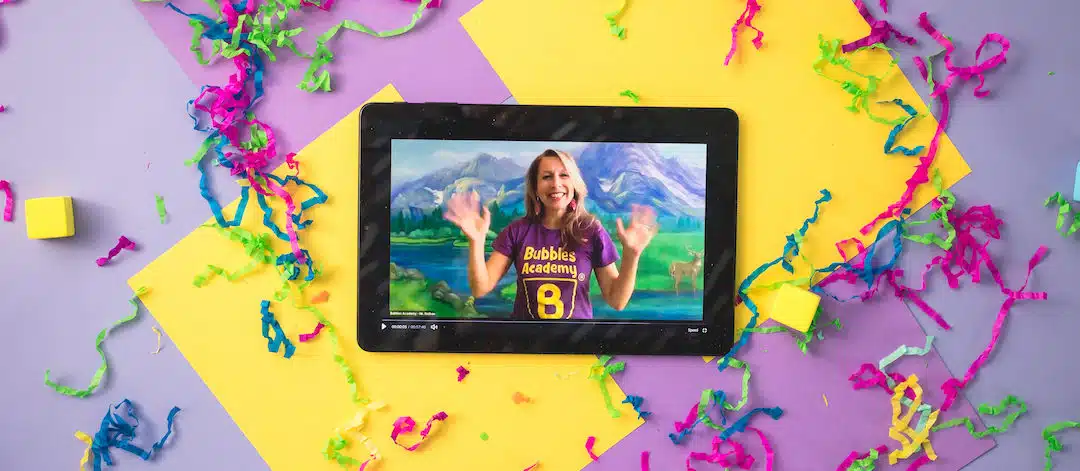We’re a few months into hosting virtual classes, and WOW have we learned a lot! Check out our tips, tricks and insights on virtual learning for the 0-5 age range below. We want to help you have the best and uniquely developmentally appropriate virtual class experience as possible!
Our #1 virtual class participation tip:
A moving or wiggling body does not mean your child isn’t listening or learning!
Sitting in front of a screen for more than a few minutes at a time and staying completely focused is developmentally inappropriate for most children under the age of 5. If your child needs to move around the room, play with a toy, or eat a snack while they are participating in a virtual class, that’s fine! In fact, it can be helpful to provide something else for their hands or body to do right at the start. You’ll be surprised when later that day, you hear them singing a song from class or bringing some elements of class into their own play.
How do I set my family up for success with virtual classes?
Adjust for your child’s age
Babies won’t be absorbing what’s on screen (in this case it’s more for you!), but they can hear the music! You can interact, sing, and physically model any finger plays or interactive elements your teaching artist is demonstrating. You become the teacher! Toddlers will get the most out of class when you watch and engage along with them, where preschoolers can watch and participate in class on their own more easily.
Model participation
This is a completely new type of engagement for most children, and they might need you to show them how it’s done! Don’t be afraid to get silly, sing, dance and get in touch with your own inner child. After you’ve given yourself and your little one permission to dive right in, it will be easier for them to do so on their own later on if you need to take time to get your own work done while they do their virtual school.
Play School
If you find that virtual school just doesn’t seem like the right fit for your child, take some time to watch some of the content provided to you, and implement the activities in real life without any screens.
Let go of expectations
There are so many different virtual options provided for young children right now, which is great, but can make some parents or caregivers feel overwhelmed. Do what makes sense for you and your family right now. Making a visual schedule of each thing on your plan for the day can help manage your child’s expectations and help build your at-home routine.
I’ve seen so many other families get class up on their TV screen… how do I work this magic?!
You can use Chromecast, an Amazon Firestick, your Smart TV or other mirroring software to broadcast our class on your TV! Click below for instructions on your specific device:
- Firestick
- Chromecast
- Smart TV: look up specific screensharing options for your model
How do I transition away from the screen when class is over?
As with all transitions, it’s always great to give a verbal cue that the transition is coming soon. As class is winding down, remind your little one that class is almost over, and when it is, the device will be going away and you’ll be moving on to another fun activity! We said it above but it’s worth repeating – making a visual schedule of your plan for the day can help manage your child’s expectations, and also take some stress off of you trying to come up with activities on the fly.
Even when you provide plenty of notice and visual and verbal cues to let your child know that a transition is coming, they may still have difficulty and express big emotions. That’s ok and will subside! Try your best to sit with your child through any tantrums or melt downs, letting them know you see their upset and understand they’re feeling sad or angry about changing activities. Also, this is a good time to offer a snack and bathroom break to your child. They may have been so engaged with their activity that their body doesn’t register their other needs. They may feel like something is off (they’re hungry, tired or uncomfortable because they need a potty break) but may lack the self-regulation skills to identify the need. That’s where your role as co-regulator kicks in and you can help them find a happy balance.
I’m worried this is all resulting in too much screen time. Is taking a virtual class different than playing in an app or watching videos?
Virtual classes and other media specifically designed for young children can be classified as “slow media.” Instructors work in time for children to process ideas and questions. There is space for them to interact in a real-time way.
This differs from high speed, “fast media,” that doesn’t necessarily take young children’s processing abilities and needs into consideration. This kind of media (action packed tv shows, movies and video games) can be extremely attractive to children (and adults), however, the sensory stimulation comes at such a fast pace, children’s executive function skills (their self-regulation system) are temporarily impaired as they work to process the quick sounds, images and storyline. This is ok and not something to worry about, but is why we try to limit the amount of fast media young children are exposed to each day. There is also the need for more transition time (see above) needed after consuming fast media, before we can expect our children to join us in a new activity. They may need a few minutes of stillness, cuddling, a snack or other regulating connection before we try to initiate a new task.
To learn more, check out this study on The Immediate Impact of Different Types of Television on Young Children’s Executive Function.

